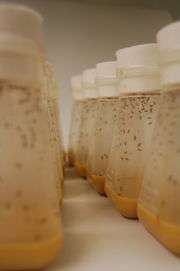Directing evolutionary changes

Since 1859, when Darwin's classic work "On the Origin of Species" was published, we have known that populations change over the course of time. The ability to adapt to changing surroundings is the basis for evolution and is crucial for animals and plants to come to terms with new environmental conditions, for example as a consequence of climate change. Despite the obvious importance of the process, however, we still do not understand the underlying mechanisms. It is clear that organisms change their DNA in response to selection pressures. But how? Important clues come from the work of Pablo Orozco-terWengel in the group of Christian Schlötterer at the University of Veterinary Medicine, Vienna. The results are published in the current issue of the journal Molecular Ecology.
In the long run, all organisms must adapt to survive as their surroundings do not remain constant for ever. The major difficulty with understanding adaption relates to the length of time required for experiments: evolution is by its very nature a gradual process. Fortunately, however, recent breakthroughs in experimental evolution using model organisms are providing important insights into the process. The nature of the underlying genetic changes has generally remained elusive but recent work at the Institute of Population Genetics of the University of Veterinary Medicine, Vienna is helping to show us how evolution may operate.
To discover what happens when an organism – in this case the fruit fly, Drosophila melanogaster – is confronted with new conditions for a prolonged period of time, terWengel and colleagues Martin Kapun and Viola Nolte subjected flies to an unfamiliar temperature regime, in which 12-hour days at 28oC alternated with 12-hour nights at 18oC. Throughout the experiment, the scientists monitored the changes to the flies' DNA by sequencing pools of female flies taken after certain numbers of generations. The complicated study was made possible by developments in sequencing technology that enable the rapid sequencing of entire genomes and by new and sophisticated software algorithms that permit the frequency of gene variants (alleles or polymorphisms) to be directly compared across different populations.
At the start of the experiment, the fly genomes contained sufficient polymorphisms to enable natural selection to act on the population. The researchers were able to confirm that the genetic changes over time were not random but presumably driven by a selective force: the X chromosome proved to be more stable than chromosome III, for example, despite its far smaller population size (each pair of flies carries a total of four copies of chromosome III but only a single X chromosome). They also showed that genetic changes were widespread and rapid: within a mere 15 generations, the frequencies of variants at nearly 5000 positions in the genome had altered significantly more than expected.
Surprisingly, however, not all changes took place at the same rate. The scientists found that while the frequencies of variants of some genes continued to rise throughout the entire course of the study (37 generations), the proportions of alleles of other genes rose rapidly at the start of the experiment but reached a plateau after about 15 generations. The reasons for this levelling out are still unclear but may relate to the fluctuating temperatures employed in the work, which could result in different selective advantages being conferred by several different alleles of a particular gene.
As Schlötterer puts it, "we expected the flies to respond genetically to the changes in their environment. But we did not expect the genetic adaptations to group so neatly into two classes, with so little overlap between them. It will be intriguing to try to find out whether the two categories of gene affect distinct groups of traits."
More information: The paper "Adaptation of Drosophila to a novel laboratory environment reveals temporally heterogeneous trajectories of selected alleles" by Pablo Orozco-terWengel, Martin Kapun, Viola Nolte, Robert Kofler, Thomas Flatt and Christian Schlötterer is published in the current issue of "Molecular Ecology" (Mol Ecol. 2012 Oct;21(20):4931-41).
Journal information: Molecular Ecology
Provided by University of Veterinary Medicine -- Vienna

















